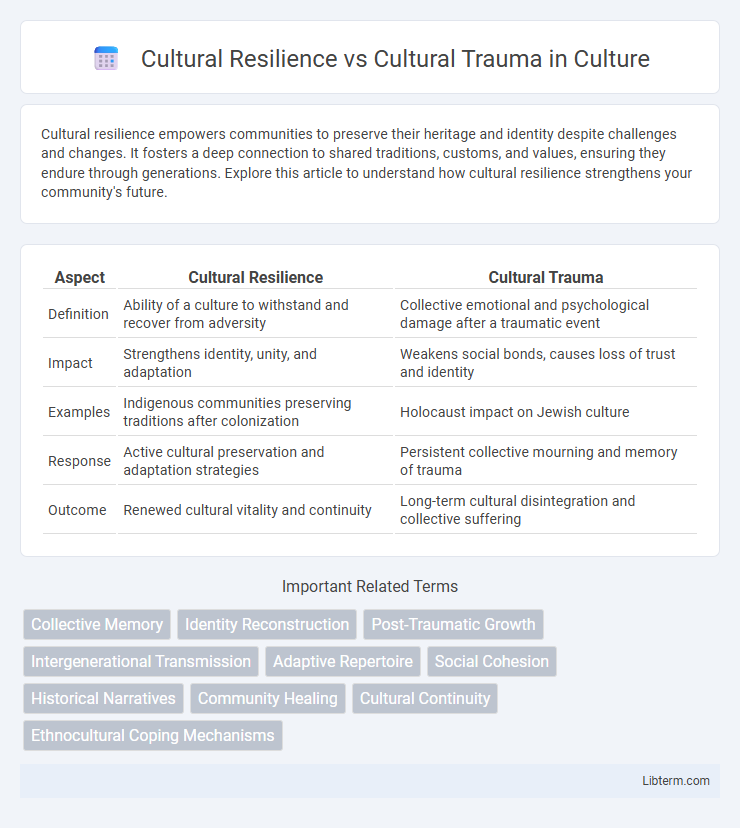Cultural resilience empowers communities to preserve their heritage and identity despite challenges and changes. It fosters a deep connection to shared traditions, customs, and values, ensuring they endure through generations. Explore this article to understand how cultural resilience strengthens your community's future.
Table of Comparison
| Aspect | Cultural Resilience | Cultural Trauma |
|---|---|---|
| Definition | Ability of a culture to withstand and recover from adversity | Collective emotional and psychological damage after a traumatic event |
| Impact | Strengthens identity, unity, and adaptation | Weakens social bonds, causes loss of trust and identity |
| Examples | Indigenous communities preserving traditions after colonization | Holocaust impact on Jewish culture |
| Response | Active cultural preservation and adaptation strategies | Persistent collective mourning and memory of trauma |
| Outcome | Renewed cultural vitality and continuity | Long-term cultural disintegration and collective suffering |
Understanding Cultural Resilience and Trauma
Cultural resilience refers to a community's capacity to maintain and rebuild its identity, values, and practices despite adversity, often drawing strength from shared traditions and collective memory. Cultural trauma occurs when an event or series of events severely disrupts a group's sense of identity, causing lasting emotional and psychological scars that affect cultural narratives and social cohesion. Understanding both concepts requires analyzing how communities process historical injustices and adapt to preserve their cultural continuity and healing.
Historical Roots of Cultural Trauma
Cultural trauma originates from historical events such as colonization, genocide, slavery, and forced displacement, which disrupt social cohesion and collective identity, leaving deep psychological and social scars across generations. This trauma shapes collective memory, manifesting in narratives of loss and victimhood that influence group behavior and cultural expression. Understanding these historical roots is essential to differentiate cultural trauma from cultural resilience, which denotes adaptive responses and the preservation of identity despite adversity.
Factors Contributing to Cultural Resilience
Factors contributing to cultural resilience include strong community bonds, preservation of traditions, and adaptive responses to adversity. Social cohesion, cultural practices, and collective memory reinforce identity and facilitate recovery from disruptions. Access to resources and effective leadership also play critical roles in sustaining cultural resilience amid challenges.
Signs and Symptoms of Cultural Trauma
Signs and symptoms of cultural trauma include collective feelings of loss, deep-seated grief, and a disrupted sense of identity within affected communities. Manifestations often involve intergenerational mistrust, social fragmentation, and cultural stigmatization, leading to long-lasting psychological and social distress. These symptoms contrast with cultural resilience, which is characterized by adaptive strategies, cultural continuity, and community solidarity that help mitigate trauma effects.
The Role of Community in Healing Processes
Cultural resilience enables communities to draw on shared values, traditions, and collective memory to recover from adversity, fostering a sense of identity and continuity. In contrast, cultural trauma disrupts this cohesion by embedding deep psychological wounds linked to historical injustices, yet communal engagement in rituals and storytelling becomes a powerful method for collective healing. Community participation in cultural practices, support networks, and intergenerational dialogue is critical in transforming traumatic experiences into sources of strength and renewal.
Intergenerational Impacts of Cultural Trauma
Cultural trauma profoundly affects multiple generations by disrupting collective identities and transmitting psychological pain through family narratives and social practices. Intergenerational impacts manifest in heightened vulnerability to mental health disorders, altered cultural expressions, and challenges in preserving traditional knowledge. Understanding these dynamics is crucial for fostering cultural resilience, which emphasizes healing, adaptation, and the restoration of community cohesion over time.
Strategies for Fostering Cultural Resilience
Strategies for fostering cultural resilience involve reinforcing community identity through the preservation of language, traditions, and rituals that strengthen collective memory and social cohesion. Implementing educational programs and storytelling practices helps transmit cultural knowledge across generations, empowering communities to adapt while maintaining core values. Supporting participatory cultural initiatives and inclusive policymaking cultivates a sense of agency, enabling communities to recover from cultural trauma and thrive despite historical adversities.
Case Studies: Resilient Cultures Amid Adversity
Case studies of cultural resilience highlight how communities such as the Indigenous peoples of Australia and the Rwandan Tutsi have preserved their identities despite historical trauma and systemic oppression. Indigenous Australians maintain language revival programs and traditional practices that strengthen social cohesion and cultural continuity. In Rwanda, post-genocide reconciliation initiatives and memorialization efforts contribute to collective healing while fostering resilience within the Tutsi community.
The Importance of Storytelling in Recovery
Storytelling plays a crucial role in cultural resilience by preserving collective memories and reinforcing identity after traumatic events. Narratives enable communities to process cultural trauma, fostering healing and continuity across generations. By sharing stories, societies strengthen communal bonds and promote recovery through a shared understanding of past experiences.
Building Sustainable Futures Through Cultural Strength
Cultural resilience embodies the capacity of communities to sustain and adapt their cultural identity amidst adversity, fostering social cohesion and continuity. Cultural trauma, by contrast, refers to the collective psychological impact of catastrophic events that disrupt cultural narratives and identity. Building sustainable futures through cultural strength involves leveraging resilience to restore and innovate cultural practices, ensuring long-term community well-being and intergenerational knowledge transfer.
Cultural Resilience Infographic

 libterm.com
libterm.com